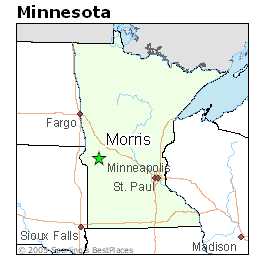 The above photo shows the new church which is joining the neighborhood just to the north of Morris. (Photo by B.W.)
The above photo shows the new church which is joining the neighborhood just to the north of Morris. (Photo by B.W.)Neighborhoods go through their transitions and we're in one now, out on the northern edge of Morris. Houses are changing hands. Ironically, the newest houses along our road are along the stretch that is not yet paved. There are times of the year when the unpaved section can get a little rough.
I think it's interesting that County Road 5 going north out of Morris got paved for several miles toward Donnelly, while our road, Northridge Drive, still has that substantial dirt stretch.
Dirt roads can become washboard-like at various times of the year. Oh, not that I personally care! More paving would certainly mean more traffic. No one really wants that from the vantage point of your residence.
I even talked to someone from that County Road 5 neighborhood once who didn't relish that road getting paved. Old-timers call that road "Yankee Ridge."
Some interesting people live along that road. When I was a kid it wasn't real inviting because, well, it was a dirt road. The stuff of country music songs. Dirt roads are an exhibit for rustic Americana, for the humble lifestyle that many see as representing our roots.
But progress rolls along and now County Road 5 ("Yankee Ridge") is a wonderful paved route for all kinds of travel including "Sunday driving." It's the No. 1 bicycling route that I recommend.
By using County Road 5 and then taking a right onto the (also newly paved) County Road 18, you can get all the way to the Pomme de Terre Lake access without using a state highway. The access isn't as well-known locally as it should be. It's a bona fide park with a shelter, swing set etc.
We have a new and significant neighbor out on the north edge of Morris. It's a church, located on County Road 5 close to the intersection of that road and Northridge. It was physically moved from its previous location.
Our family attended two lutefisk suppers there when it was at its former site several miles south of Alberta. It was a classic "country church," a charming little white building where you could just imagine people in an earlier era arriving by horse and buggy.
This new church in Morris makes us think of changing times. So does Northridge Drive. Let's compare: The church had its doors closed at its previous location because of the notorious population drain in the rural Upper Midwest.
The Agralite-News publication, in an article about the church in its September edition, reported that Good Shepherd Lutheran Church had a membership "near 150 families" in the 1960s.
Wow! It's almost scary to ponder what has happened since.
"With declining membership from the rural community, this church building had become a common symbol of the changing times of rural America," the article reported.
"Changing" or "declining."
One of the first blog posts I ever wrote was a book review for "Hollowing Out the Middle," which explored the depopulation of the rural Upper Midwest. I only read about a third of the book because I was repulsed by many of the condescending knee-jerk judgments and stereotypes by the two academic sociologists who wrote it. I didn't need to read the other two-thirds because I knew what they were going to say, just looking at the chapter headings.
I took college social science classes. College social science professors can be the most narrow and parochial people you'll ever meet, unless things have changed since the 1970s. I suspect these individuals have moderated a little. But I'm fairly certain those recognizable spots are still there.
They probably aren't the blatant leftists or elitists they once were (or at least they soft-pedal it). Someday courses like "Sociology 101" will be retired to the dustbin and everyone will say "what took so long?"
Good Shepherd Church and my Northridge Drive have both felt the effects of changing demographics. Northridge Drive in the 1960s (its first decade of existence) was throbbing with the sugar high of kids!
Every neighborhood in Morris had kids that would define that neighborhood. I remember being close to the South Street kids in my youth. "The South Street Kids" - nice name for a movie. Reminds me of "The Bowery Boys" (with Huntz Hall).
These were the unique years of the baby boomer youth. The World War II generation had found prosperity in the post-war years and celebrated with large, robust families. The kids showed lots of imperfections with their behavior but we learned to mesh, to grow and to get past most of the hazards that confronted us.
The institutional resources for youth were far less than today, which represents huge irony.
There were no girls sports in schools until the mid-1970s. There was no real special education. Kids with special needs (with terms/diagnoses that weren't even coined yet or weren't familiar to us) had to fight to get through in the mainstream.
Some might argue this was good. You couldn't fall back on the excuse of some "diagnosis" (like high-functioning autism). Many kids struggled because of this, I'm sure.
But there is no perfect system, is there? Because man, after all, is not perfectible.
There were no child car seats then. Many of our parents (not mine) drank to excess and it was considered fairly normal behavior. Driving while drunk wasn't stigmatized like today. Catholic priests - I'm not speaking locally - misbehaved but with little notice.
There was no indoor ice arena in Morris. Hockey was a sandlot sport and people my age can remember the handful of "rink rats" in each grade who enjoyed the sport as best they could with limited resources.
Girls were supposed to enjoy "home ec."
Today we micro-manage our kids' upbringing. Every conceivable weakness is addressed. Kids aren't trusted to police themselves, they are under a microscope. They aren't groomed to be self-starters.
Problem is, there are so many fewer kids today. It's a whole different world in this regard. Northridge Drive has been practically bereft of kids. I believe there are a couple of preschool ones now, but I can't remember the last time a school bus even rumbled by here.
My goodness, in the 1960s a clunky orange bus would make about four stops along our neighborhood. I'd wave to Steven "Skip" Sherstad, a year older than me, who was three houses down.
Those were the days of 150 families belonging to Good Shepherd Lutheran Church south of Alberta.
Today we live in a community where senior citizens seem almost to predominate. It's wonderful to have that element in our population and to see medical science prolonging the lives of our elders.
But don't you feel a little nostalgic for the days when every neighborhood in town had its gang of kids? Like the "South Street kids?"
Those kids had no inhibitions about playing unsupervised, out and about around town. A lot of dogs ran loose too.
Today the media can raise the fears of parents so much, kids are kept indoors where they play video games and become obese. The media sensationalize cases of child endangerment and abuse. Such behavior (like that of certain notorious Catholic priests) is nothing new.
An earlier generation of parents prayed that their children would stay safe but they didn't obsess about creating a "cocoon" for them. They realized the world around them was inherently risky. They had survived the Depression and World War II.
With that as a backdrop, they could live with some of the imperfections in the environment in which their kids grew up. Risk was part of the fabric that God wove around us.
Good Shepherd Lutheran Church may find new life just to the north of our community (just to the north of Cimaroc Kennels, causing a friend of mine to refer to the church as "the dog kennel church").
Personally I think the church does a disservice. We have enough churches in town now. I think it's safe to say they aren't all virtually thriving.
Certainly there's an existing church that could meet your needs. The individuals who are pouring tens of thousands of dollars into starting the new church could apply that money in a more constructive way.
Is it so terrible that the Evangelical Lutheran Church in America (ELCA) is showing a touch of progressiveness?
The new church is a statement by traditionalists who will develop the church as a bulwark against that change, based on what I've heard from credible sources.
It isn't necessary.
Besides, County Road 5 doesn't need development. Its beauty has been in its pristine nature.
Good Shepherd may become viable but it probably will never duplicate what we saw in those years when the baby boom population created such a lively and unforgettable world around us. It was a culture that celebrated children. It was the kind of culture, even with its occasional cruelty and imperfections, that God would most certainly bless.
(A footnote: Google spell-check does not approve of "lutefisk!")
-Brian Williams - morris mn Minnesota - bwilly73@yahoo.com






















No comments:
Post a Comment